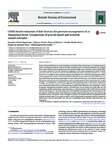Por favor, use este identificador para citar o enlazar este ítem:
http://www.alice.cnptia.embrapa.br/alice/handle/doc/1055435Registro completo de metadatos
| Campo DC | Valor | Lengua/Idioma |
|---|---|---|
| dc.contributor.author | FIGUEIREDO, E. O. | pt_BR |
| dc.contributor.author | OLIVEIRA, M. V. N. d' | pt_BR |
| dc.contributor.author | BRAZ, E. M. | pt_BR |
| dc.contributor.author | PAPA, D. de A. | pt_BR |
| dc.contributor.author | FEARNSIDE, P. M. | pt_BR |
| dc.date.accessioned | 2016-10-26T11:11:11Z | pt_BR |
| dc.date.available | 2016-10-26T11:11:11Z | pt_BR |
| dc.date.created | 2016-10-26 | pt_BR |
| dc.date.issued | 2016 | pt_BR |
| dc.identifier.citation | Remote Sensing of Environment, Amsterdam, v. 187, p. 281-293, Dec. 2016. | pt_BR |
| dc.identifier.issn | 0034-4257 | pt_BR |
| dc.identifier.uri | http://www.alice.cnptia.embrapa.br/alice/handle/doc/1055435 | pt_BR |
| dc.description | Based on airborne LIDAR data on canopymorphology and height of Amazon forest trees, we developed allometric models to estimate dry biomass stored in the boles of dominant and co-dominant individuals and compared these results with those from equations based on traditional variables such as diameter at breast height (DBH). The database consisted of 142 trees of interest for logging in a forest under management for timber in Brazil's state of Acre. The trees chosen for studywere selected through proportional sampling by diameter class (ranging from45 to 165 cm DBH) in order to properly represent the dominant and co-dominant tree populationswith diameters appropriate for harvest. Subsequent to LIDAR profiling of these trees, they were felled, subjected to a battery of dimensional measurements and sampled for wood-density determination. A set ofmodels was generated, followed by model selection and identity testing in order to compare groups of basicwood density (low, medium and high). The morphometric variables of the crown had high explanatory power for bole biomass independent of whether the allometric equations included DBH. When calculating bole biomass with equations that include basic wood density, the best estimate is obtained using variables for both DBH and crown morphology. To obtain an allometric equation that encompasses species in all three classes of basic density, one should either use only independent variables representing crown dimensions or complement these with variables for basic density (BD) and total height (Ht). The study demonstrates the feasibility of using ground-based measurements to calibrate biomass models that include only LIDAR-based variables, allowing much larger areas to be surveyed with reasonable accuracy. The present study is designed to produce data needed for forest management, but the methods developed here can be adapted to studies aimed at reducing the uncertainty in biomass estimates of whole forests (not just harvestable trees) for use in quantifying carbon emissions from forest loss and degradation. | pt_BR |
| dc.language.iso | eng | eng |
| dc.rights | openAccess | eng |
| dc.subject | Geotécnica | pt_BR |
| dc.subject | Manejo de precisão | pt_BR |
| dc.subject | Floresta Estadual do Antimary (AC) | pt_BR |
| dc.subject | Acre | pt_BR |
| dc.subject | Amazônia Ocidental | pt_BR |
| dc.subject | Western Amazon | pt_BR |
| dc.subject | Amazonia Occidental | pt_BR |
| dc.subject | Acumulación de materia seca | pt_BR |
| dc.subject | Análisis estadístico | pt_BR |
| dc.subject | Bosques tropicales | pt_BR |
| dc.subject | Cubierta (plantas) | pt_BR |
| dc.subject | Manejo forestal | pt_BR |
| dc.subject | Modelos matemáticos | pt_BR |
| dc.subject | Producción de biomasa | pt_BR |
| dc.subject | Programas de computadores | pt_BR |
| dc.subject | Teledetección | pt_BR |
| dc.title | LIDAR-based estimation of bole biomass for precision management of an Amazonian forest: comparisons of ground-based and remotely sensed estimates. | pt_BR |
| dc.type | Artigo de periódico | pt_BR |
| dc.date.updated | 2017-07-06T11:11:11Z | pt_BR |
| dc.subject.thesagro | Floresta tropical | pt_BR |
| dc.subject.thesagro | População de planta | pt_BR |
| dc.subject.thesagro | Biometria | pt_BR |
| dc.subject.thesagro | Biomassa | pt_BR |
| dc.subject.thesagro | Matéria seca | pt_BR |
| dc.subject.thesagro | Sensoriamento remoto | pt_BR |
| dc.subject.thesagro | Raio laser | pt_BR |
| dc.subject.thesagro | Modelo matemático | pt_BR |
| dc.subject.thesagro | Análise estatística | pt_BR |
| dc.subject.thesagro | Programa de computador | pt_BR |
| dc.subject.thesagro | Flora | pt_BR |
| dc.subject.nalthesaurus | Tropical forests | pt_BR |
| dc.subject.nalthesaurus | Forest management | pt_BR |
| dc.subject.nalthesaurus | Canopy | pt_BR |
| dc.subject.nalthesaurus | Biomass production | pt_BR |
| dc.subject.nalthesaurus | Dry matter accumulation | pt_BR |
| dc.subject.nalthesaurus | Remote sensing | pt_BR |
| dc.subject.nalthesaurus | Lidar | pt_BR |
| dc.subject.nalthesaurus | Mathematical models | pt_BR |
| dc.subject.nalthesaurus | Statistical analysis | pt_BR |
| dc.subject.nalthesaurus | Computer software | pt_BR |
| dc.subject.nalthesaurus | Lásers | pt_BR |
| dc.subject.nalthesaurus | Amazonia | pt_BR |
| riaa.ainfo.id | 1055435 | pt_BR |
| riaa.ainfo.lastupdate | 2017-07-06 | pt_BR |
| dc.contributor.institution | EVANDRO ORFANO FIGUEIREDO, CPAF-Acre; MARCUS VINICIO NEVES D OLIVEIRA, CPAF-Acre; EVALDO MUNOZ BRAZ, CNPF; DANIEL DE ALMEIDA PAPA, CPAF-Acre; Philip Martin Fearnside, Instituto Nacional de Pesquisas da Amazônia/RedeClima. | pt_BR |
| Aparece en las colecciones: | Artigo em periódico indexado (CPAF-AC)  | |
Ficheros en este ítem:
| Fichero | Descripción | Tamaño | Formato | |
|---|---|---|---|---|
| 26171.pdf | 516,3 kB | Adobe PDF |  Visualizar/Abrir |









